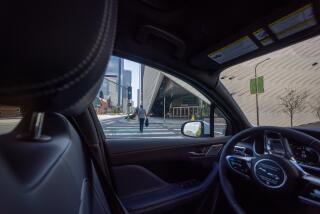Americans Urged to Trade Horsepower for Footpower
- Share via
WASHINGTON — It took Americans decades to forget how to walk, and experts think it could take longer to relearn it.
But if nothing changes, people will keep padding on calories they should burn off, setting themselves up for diseases of obesity such as diabetes and heart conditions, the researchers say.
The bleak prognosis follows a series of reports on America’s preference for cars over walking or biking. Researchers see the trade of horsepower for footpower as just one way in which the nation has engineered healthful physical activity out of normal living. They say the time has come to engineer its return.
“What we are trying to get people to understand here is, the environment could create better choices for them to achieve a healthier lifestyle,” said Richard Killingsworth, director of Active Living by Design, a community planning program based at the University of North Carolina, Chapel Hill.
But re-engineering won’t be easy. It took decades to make things bad, and change will require “having the will of the people to do this for decades out,” Killingsworth said.
Killingsworth is a co-author of a study that compared car-dependent sprawling communities with compact, foot-friendly cities. Residents’ weight increased as the degree of sprawl rose, the study said.
The most sprawling counties had a greater proportion of adults with high blood pressure and obesity, said Reid Ewing, an urban planner with the National Center for Smart Growth at the University of Maryland. Ewing was lead author of the report in the September/October issue of the American Journal of Health Promotion.
America is not biker- or walker-friendly. “It’s 23 times more dangerous to walk a mile than to ride a mile in a car,” said John Pucher, an urban design professor at Rutgers.
Federal statistics show that in 2000, some 4,598 pedestrians and 740 bicyclists died.
American pedestrians also are about three times more likely to get killed than German pedestrians, and more than six times more likely than Dutch pedestrians, even though Europeans bike and walk more, said Pucher’s report in the September issue of the American Journal of Public Health.
Biking and walking account for half of all urban trips in the Netherlands, a third of German trips, but less than a tenth of all trips in American cities, the study said.
One reason: Europe makes such trips easy but America makes them difficult, Pucher said. At least 20 years ago, European leaders took steps that encouraged walking and cycling while dramatically reducing fatality and injury rates, he said.
The Europeans poured money into such things as bike paths and bike-only traffic lanes, pedestrian refuge islands for crossing wide streets, and clearly marked, raised crosswalks, Pucher said.
European drivers have empathy for bikers and walkers, Pucher said. “Even people who drive a high percentage of the time are also walking and cycling at other times,” he said.
Walkers and bikers also are voters, and their numbers are large enough to make politicians pay attention, Pucher said. “In the United States, so many drivers never get on a bike and rarely walk, and see the world just through the windshield of a car.”
Urban planners think Americans can lose some of their love of the internal combustion engine and get around more under their own steam. “People are beginning to understand why it is so important,” said Julie Mercer Matlick, a community program manager with the Washington state Department of Transportation.
Health officials are working diligently to turn things around at the local and state levels, Matlick said. “But transportation dollars start at the top, at the federal level, and that’s not as strongly supported,” she said. “It isn’t important to congressmen.”
More to Read
Sign up for Essential California
The most important California stories and recommendations in your inbox every morning.
You may occasionally receive promotional content from the Los Angeles Times.










